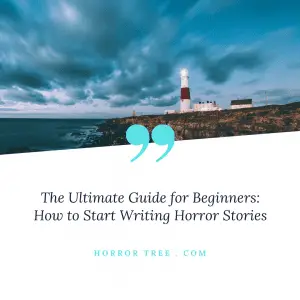The Ultimate Guide for Beginners: How to Start Writing Horror Stories
 The Ultimate Guide for Beginners: How to Start Writing Horror Stories
The Ultimate Guide for Beginners: How to Start Writing Horror Stories
Horror is a creative writing or storytelling genre that seeks to tap into the reader’s emotions and instill fear in them. Although horror stories are often classed with the broad category of thrillers, not all horror stories are thrillers or have a thriller structure. Classic horror fiction stories – expressed as a film, short story, novel, or novella – that tap into topics known to frighten most people. Some of these topics are ghosts, vampires, werewolves, serial killers, zombies, murderers, and reliably “fear of the unknown.”
Horror stories have become very popular over the years, which has become a downside for this niche. There are now several horror movies and books that recycle old content and do it in uncreative manners. However, when horror stories are correctly executed, they can thrill the audience, and they also make commentary on human conditions.
Components of an excellent horror story
There are four major components of an exciting horror story:
- Fear: this is an obvious one. If it doesn’t have an element of fear, then it cannot be a horror story. However, it may be more challenging than you think it is to create a story that’s genuinely terrifying for adults to read. Doing this rests on the ability of the writer to create tension. Although we all have our different fears, to create a genuinely terrifying horror story, you must be able to create fear from something that your audience would never expect or suspect to create that kind of emotion. That’s the secret to a successful horror story.
- Revulsion: another attribute of an excellent horror story is its ability to make readers feel disgusted. There are examples of successful horror story franchises such as Saw that have used this element of disgust to devastating effect.
- Surprise: creating surprises is essential for a horror story. When people face an idea or concept that they are not familiar with, they’re likely to struggle with comprehending it. Since it is something unknown to them, the most typical first reaction that they will show is fear. This is what makes surprise a practical element for horror stories to instill fear in the readers.
- Terror: this is the next level of fear. Terror combines all of the elements mentioned above and adds another extremely potent ingredient: the human imagination. The combination of fear, revulsion, surprise, and imagination is terrifying. Sometimes, a simple suggestion of evil is all that it takes to portray something very terrifying in the human mind.
Tips for writing a horror story
Now that you understand the different components of a horror story, here are a few tips from essay help UK write a successful horror story:
1. Use common fears
The fear factor of a horror story is the most crucial part of the story. People who read horror don’t do it because they want easy entertainment. On the contrary, they want to be terrorized and titillated. Here are some elements that you can employ to achieve this:
- Instinctive fears
These fears have some biological or logical foundation. They are the most potent way to create horrors. Darkness, heights, spiders, and snakes are common phobias from people’s instincts, so they are usually effective for frightening readers.
Instinctive fears are even more effective when innocent characters are the recipients of the terror.
- Supernatural beings or monsters
This element goes past logic. For instance, it is common knowledge that ghosts, vampires, and werewolves are not real, but they still get to shake people to their core. The uncertainty that these creatures create is why they are so sinister. People start to wonder whether these monsters exist, but they just haven’t seen them. This creates fear of the unknown in them, which is a prevalent feature of horror stories.
2. Create the right atmosphere
The type of horror story that you are writing will determine what the right atmosphere is or should be. The atmosphere or tone in your story will depend to a large extent on its subgenre:
- Thriller horror uses psychological fear, which starts close to the beginning of the story before much has happened.
- Gross-out horror includes vivid descriptions involving gouged-out organs, hacked-up flesh, and spurting blood to shock and terrify the reader.
- Classic horror traces its way back to the Southern Gothic or Gothic genre with bone-chilling characters and spooky settings similar to Dracula and Frankenstein.
- Terror provokes a feeling of dread for the reader, and this can either be the climax or peak of the story, or it may be sustained throughout the story.
Subgenres can also be combined, especially as the story progresses. For example, you can start with a thrilling psychological horror before moving to the gothic undertones.
3. Make sure the stakes are obvious
Your readers must be aware of the stakes to make them thrilled as they read through. Make it clear and obvious what the stakes are from the onset. Establish the problem for the character and what’s at stake if they fail. Your motivation or stakes may be:
- Survival: all horror story characters seek survival. That’s the basic objective, but this goal has some nuances that come with it. So, the purpose might be more than just being alive. It may be to defeat the enemy while trying to survive.
- Protecting loved ones: the stakes are higher when the protagonists have many people to keep alive. Some horror stories and movies peak when there are threats of death to the loved one of the main character.
- Solving mysteries: horror stories may not always be about escaping a present danger. It can also be about solving past terrors.
Conclusion
Horror stories are fascinating to read, but they are not as easy to write. Creating fear in the hearts of people reading your story takes a lot of skill.
Author Bio
Thomas Jackson is a professional freelance content writer and an active member of several writing clubs in New York. He also works for professional writing services, where he provides dissertation proofreading service and essay writing service reviews. He has written several songs since he was a child. He gets inspiration from the live concerts he does in front of close friends and family members.
- About the Author
- Latest Posts
The Horror Tree is a resource for horror authors which was created in 2011. The main goal when starting the site was to include all of the latest horror anthologies and publishers that are taking paying submissions. A resource useful for both new and experienced publishers alike looking for an outlet for their written material!

 Thomas Jackson is a professional freelance content writer and an active member of several writing clubs in New York. He also works for
Thomas Jackson is a professional freelance content writer and an active member of several writing clubs in New York. He also works for 










